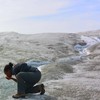Anyone who has sweltered through yet another urban heat wave might fire back at the idea that you can make a city too cool. And yet, climatologist Haider Taha says it's possible.Taha is the president of Altrostratus, which developed California's recently-published urban heat island index map. The map shows the areas most impacted by the urban heat island effect, a phenomenon in which the tightly woven fabric of buildings, roofs, and roadways that comprise cities absorb more of the sun's energy than the surrounding countryside.
Advertisement
The urban heat island effect has been known since the 1800s, but concern over it has grown in recent years because of climate change. According to the US EPA, cities with a 1 million or more people can be 1.8–5.4°F (1–3°C) warmer due to the heat island effect.This has led to a number of efforts to cool cities, such as planting trees and studying the feasibility of cooler roads that reflect instead of absorb sunlight."If the goal is to cool the air inside the city, the three common approaches are to use reflective roofs, reflective pavements, or to add vegetation," said Ronnen Levinson, a researcher in the Heat Island Group at Lawrence Berkeley National Laboratory. The goal is to have solar energy reflected back to space rather than absorbed.Unfortunately, the calculus isn't that simple.Research has shown that a city experiencing the urban heat island effect may not be responsible for it; depending on wind patterns and air flow, it may be a neighboring city that is the source of the issue.Even if a city works hard at dialing down its local thermostat, "there's only so much you can do if your upwind neighbor is dumping all the heat at you," Taha said.There is also a danger to cooling a city too much. "When you get to a certain threshold, if you start cooling too much, it starts affecting the local [air] flow pattern, mixing, cloudiness, and so on," Taha said.Cooling cities is generally associated with benefits, including lower energy usage, but it's possible to create new problems by tinkering too much with a city's temperature.
Advertisement
Wind patterns form due to differences in surface temperature, Taha said, and changes will affect weather and air pollution. Changing temperatures in a city could eliminate winds that would have flushed out pollution, making air pollution worse, he said. "In the eastern US, where clouds form due to convection winds, models have shown excess cooling can shrink cloud formation 4 to 5 percent while also reducing rainfall," he said.
Other studies have shown that the urban heat island effect, as well as measures taken to mitigate it, can impact the likelihood of tornado formation.Pinpointing where cities are naturally hot and where the heat island exerts its presence has remained elusive until now. In September, the California Environmental Protection Agency unveiled a statewide urban heat island tracking index map, the one Taha helped build.While some results were obvious—Los Angeles, which is somewhat infamous for its highways and paved surfaces, has a significant heat island effect, for example—others were more surprising. For example, the city of Bakersfield, which is known for soaring temperatures, doesn't have a significant heat island effect: it's just hot. And then there's the term "heat island" itself, which suggests unusual hot spots, surrounded by by a sea of cooler landscapes. In places like southern California where there's see a near-continuous carpet of urbanized areas, the terms a bit of a a bit of a misnomer.It "is pushing cities in the same direction as global warming is. Cities are getting a double whammy in terms of their heat burden"
Advertisement
"It's a continuous archipelago in these cases," said Taha. "It's hard to see where the heat island is, and you see the higher temperature mostly occurs downwind." The heat is shunted there from hot upwind archipelagos. Even more startling, the heat island effect is strongest when cities are already their hottest, during heat waves. An earlier study on Baltimore found that while normally the heat island effect raises nightime temperatures in cities by .9˚ F(.5˚ C) , during heat waves the effect raised temperatures by 4.5˚ F (2.5˚ C).The effect certainly has climate scientists alarmed. It "is pushing cities in the same direction as global warming is," said Stuart Gaffin, a research scientist at Columbia University's Center for Climate Systems Research. "Cities are getting a double whammy in terms of their heat burden.""There's a big correlation between increased temperatures and a range of different health problems," said Alex Barnum, deputy secretary for communications and external affairs at the California EPA "We see hospital visits go up substantially. There's an increase in 9 percent of pre-term births for every increase of 10˚ F (5.2 ˚ C) [over normal temperatures]. We're going to be seeing a lot more of those heat waves as the climate changes."California's new heat island index map is a first step toward understanding what needs to be done, but Taha says it's descriptive not prescriptive, much like a scale can tell you that you're overweight, but not the best way of losing the extra pounds."If you look at the map and say 'that's the highest temperature, it will help if you cool down that particular region,' it's not the whole problem," he said. "You have to look at the entire region and develop mitigation plans accordingly."
